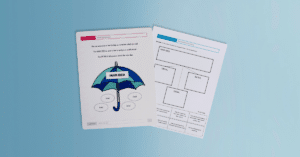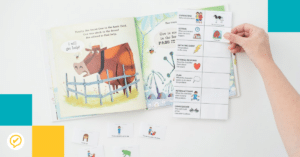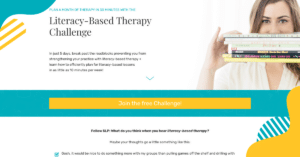Listen on Apple Podcasts Listen on Spotify
Want to hear more about this topic? Click here for all things therapy planning!
In this week’s episode of the SLP Now podcast, I break down my therapy routine (and how the routine helps me and my students)!
Topics Covered
– Your Core Materials (assessments, teaching tools/visuals, YOU!)
– Organization Tips: Easily pull together your assessments and visuals! You don’t need a ton of stuff to make this work.
– Criteria for Selecting Supplemental Materials
Subscribe & Review in iTunes
Are you subscribed to the podcast? If you’re not, subscribe today to get the latest episodes sent directly to you! Click here to make your listening experience auto-magic and as easy as possible.
Bonus points if you leave us a review over on iTunes → Those reviews help other SLPs find the podcast, and I love reading your feedback! Just click here to review, select “Ratings and Reviews,” “Write a Review,” and let me know what your favorite part of the podcast is.
Thanks so much!
Transcript
Speaker 1: Let's dive into talking about building your core materials. So this is another huge time saver, because if you have all of the materials that you need for the rest of the school year, then all you need to do is find like a book unit or something to supplement and give a context for that teaching, then you're golden. You're good to go. This is the biggest little ... The single nicest thing that you can do for your future self as a clinician to get yourself set up for success and just be ready for whatever comes your way.
So the best way that I've found to tackle this is to fill in what I call a caseload at a glance. And I do have a template that I share on my blog, but you can definitely use just a blank piece of paper and draw some lines. So it's a sheet, and I sort it by grade level, because I try to see students ... Grade level or class, because I try to see students in that context. I don't see a lot across grade levels. So what I'll do is I'll put the grade or the name of the class, and then I have different ... So I put that all in one column. So it would be like, "Joan Smith, Clancy," all of the teachers names down the paper. And then I would draw some lines, make a little grid, and for maybe the first column would be articulation. The second column could be language, or however you want to group your different goals, you can do it that way. Or if you don't want any groupings, you can just leave it blank.
But then, once I have that set up, I go through my student's IEPs and I start, I'll go through and just look at their goals. So let's say we're filling in Smith's class. So the first IEP that comes up is Joe. So I look at Joe's IEP, he's working on K and word. So I would write K and then I would put a tally next to K under articulation. Then, next he's working on following directions. So under language I would write, "Following directions, one." And then let's say he's working on S blends also. So I would write S blends, and then add the tally. Then we go to the next IEP and Sally is working on K as well. So I would just add a tally next to K. Oh, and she's also working on following directions so I add another tally, and she's also working on past tense verbs. So I would write, "Past tense verbs," under grammar, and add a tally.
Okay. So I know this sounds a little bit like, "Why in the world would you do that?" But can you imagine just seeing your whole case load, all of your students' goals all mapped out, ready to go? And then all you have to do is put together the materials for those skills. And it's just really nice seeing it mapped out in this way, because then you can prioritize. If you have 15 students working on following directions and you have two students working on past tense verbs, then if you spend some time making sure you have a good visual and a good strategy to teach and assess following directions, then you've just made a ton of progress in your therapy planning. Whereas if you focus on just dabbling, you do all of the things that maybe just one or two students are working on, then you still have a lot more work to do. So it's just a way to get yourself as far ahead as quickly as possible. And ideally we want to have all of these materials ready to go right away. But it's just really nice to see it mapped out.
And so I will write this out, I'll make a couple copies of it, and I'll use one to help me make sure that I have assessments for all of the goals. And ideally I have the assessments already ready to go, because hopefully I'd prep them when I wrote the goal for the IEP, but this is just a good way to make sure that I've got good assessment strategy for those goals. I also use it to make sure that I have like visuals and teaching materials for those different skills. And then I also use it if I'm looking for professional development opportunities, I use it to rate which areas I'm feeling really good about. And if I have, like I said, 15 students working on following directions and I'm not feeling so great about the strategies I'm using to teach that skill, I am going to sign up for ... If I have a choice of courses, I'm going to go to that first based on how I feel about it and how many of my students are working on it. So it's just a way to manage all of the things that we're trying to juggle, and just prioritizing. Because we can't do everything all at once, and that's just a way to make it really easy and clear to know what our next steps are.
So that's how I start tackling that. That's how I work through that. And like I said, you can pull these materials from ... You can look for visuals on it in your speech room, teachers pay teachers, you can make your own, there's so many different options. As long as you just have a way that you can scaffold these skills for students. Sometimes I even draw posters in the therapy session with students. Sometimes that works the best out of all the options. So, like I said, it's just a way to prioritize and organize.
Then in terms of keeping it all organized, I'm a big organization nerd, so I have to share. But before doing in person therapy, I really like having a tote where I have ... I keep my assessments in a binder and then they keep my visuals in file folders. So it's just really easy to open up the assessments that I need and easily pull out the visuals as I need them as well. And that's how I do that. And so by using this approach, you can easily pull together, like I said, your assessments, your visuals, and then also you, because you are your best therapy resource. And the knowledge in your brain is what is ... You can do therapy with anything essentially, if you have the evidence based strategies and everything ready to go in your pocket. You can make it work with anything. So that's the cool part, is that you don't need a ton of stuff to make this work. Just need your awesome brain.
But here's just a quick example of what a visual might look like. So for following directions, there are some tricky syntax pieces. So I created a visual where I can ... So I can use it. I typically put them in sheet protectors so we can use dry erase markers and everything, but then we can use them in a variety of different activities. So we can use them when we're playing with pretend food, or when we're getting ready for a session and prepping the materials, whatever it may be. I can use that in that context and have it be super meaningful.
Okay. And so then just some additional criteria to think about when we're putting those together. So we want it to be ... In terms of the materials that we pick to supplement our core visuals and assessments and all of that, like we talked about before, curriculum based is awesome if we can make that happen. But if anything, just having it be educationally relevant. So if we can link in any way to what they're working on in the classroom, whether it's covering similar themes or different, similar types of texts, then that can be incredibly impactful and meaningful for students. And Yukranitz is my SLP hero. She talks about ... She just emphasizes the importance of providing explicit skill instruction. So teaching these skills, but doing it in ways that are meaningful and purposeful to the student. So really thinking about the end goal and where we want them to go. And then Asha also has some nice guidelines for us, saying that individualized programs always relate to the schoolwork. Therefore, materials for treatment are taken from, or are directly related, to content from classes. So that's just that guidance from Asha, just emphasizing the importance of getting that set up.
Sign up to receive email updates
Enter your name and email address below and I'll send you periodic updates about the podcast.




Reader Interactions